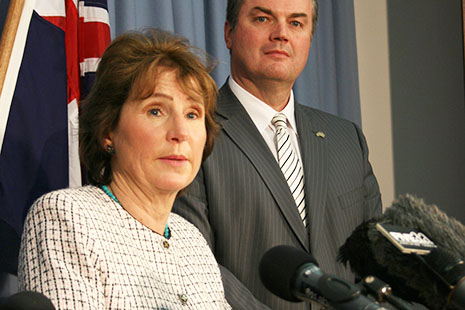IN JULY 2009 the Labor Party was cruising towards re-election on 20 March 2010, possibly with an increased majority. Premier Mike Rann was streets ahead in the popularity polls and his party held twenty-eight of the forty-seven seats in the House of Assembly. A uniform swing of over 12 per cent was needed to deliver to the Liberal Party the ten extra seats it needed to win government.
The Liberals, meanwhile, were in turmoil. The party had gone through three leaders in three years and was riven by factional warfare. In July, after the “dodgy document” case brought Martin Hamilton-Smith undone, the party selected its fourth leader since it lost government. Isobel Redmond made the headlines as the first female leader of a major party in South Australia. First elected in 2002, she now faced a divided party and a savage government attack on her elevation.
There was no real evidence that the Rann government was under any significant threat. A poll in June 2009 showed Labor’s first preference vote at 42 per cent compared to the Liberals’ 23 per cent, which translated into a two-party split of 64–36 in favour of Labor. The poll was conducted in the Adelaide metropolitan area, so it probably understated the statewide Liberal vote. But as Labor holds only one seat in the country, the city will decide the election.
But then it all seemed to fall apart for Labor. The premier faced an allegation from a former parliament house waitress that there had been a torrid affair. Rann emphatically denied this, but the story and the public’s discussions continued.
Attorney-General Mick Atkinson then caused embarrassment when he announced a new law requiring that all blogs and online comments during the campaign would have to include the correct name and postcode of the author. The opposition from the media and the public was immediate. But what forced him to rethink the plan was closer to home: he had asserted that a series of anti-Atkinson web commentaries had been concocted by the Liberal Party rather than written by a real person. It took only a day for the Advertiser to find and interview the author of the pieces.
The attorney-general was under sufficient pressure to announce that the law would be withdrawn, retrospectively, after the election. As it still applies during the campaign, he undertook to deal with it by regulation.
AFTER its landslide election in 2006, and with the Liberals’ internal shambles, the Rann government became more than a little arrogant. Any criticisms were brushed aside, and spin increased exponentially. It was clear that the Labor Party remained supremely confident.
That confidence isn’t completely unfounded. The South Australian economy is healthy, and has weathered the global financial crisis well. Infrastructure is finally receiving some attention. Mining developments are about to come on stream, bringing welcome royalties. The defence sector is growing. South Australia’s unemployment rate is the lowest in the nation.
Normally, this scenario would be a plus for the government, if only it could be turned into a major campaign discussion point. But the good news has been overwhelmed by the negatives.
The first sign of what was to come was a poll in early February that showed Labor’s lead narrowing to four points. On top of that, only 34 per cent of respondents stated that they trusted Premier Rann, while 51 per cent trusted Ms Redmond.
A month later, with the election just ten days away, the government’s attempts to regain its dominant position are hampered by the fact that Adelaide is in a party mood. The Adelaide Festival, the Fringe, the V8 street race and assorted other enjoyments are hardly the time to capture the attention of swinging voters.
Complicating the contest between Labor and the Liberals is the presence of four sitting independent MPs and one Nationals member. The National, Karlene Maywald, has been a member of the Rann Labor cabinet for seven years, with the most difficult of all portfolios – water and the Murray. Her electorate straddles the river, and mainly comprises irrigation farmers. There, the contest is Nationals versus Liberals.
Of the four independents, one is retiring, and his seat will almost certainly become Liberal. That leaves three independents who may have a key role after the election.
There is only an outside chance of the Liberal Party’s picking up the ten seats it needs to form a government in its own right. Given the polls to date, it is likely that the Liberals will retain all their current seats. Hence the party’s target is to win five more seats to force the Rann government into a minority. If it can win those five, then the numbers in the house would be Labor 23, Liberal 20, one National and three independents.
The latest Newspoll, published on 9 March, really focused the Labor Party’s attention. Using responses collected between January and March 2010, the poll showed Labor and Liberal tied on 50 per cent of the two-party vote – a swing to the Liberal party of 6.2 per cent from the 2006 election. Labor’s primary vote had slumped from 45 per cent in 2006 to 36 per cent in the 2010 poll.
Most tellingly, however, the evidence suggests that Labor’s decline started with the election of Isobel Redmond to the Liberal leadership. Since then, the trend line has been down. It has become increasingly clear during the campaign that Labor is still trying to work out how to deal with a female Liberal leader.
The extent to which a major change has occurred in a very short period is shown by the answers to the question, “Who would make the better premier?” It is a long time since Mike Rann has been as low as 44 per cent and his opponent as high as 41 per cent. There are interesting times ahead. •




